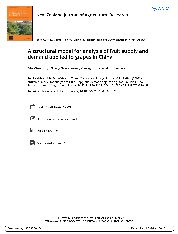摘要
A structural model for fruit supply and demand was established based on the economic anticipation theory and a hypothesis of fruit producer input behaviour under risk conditions. The model invokes the partial adjustment hypothesis and uses a deductive method. It can be used for quantitative analysis of the relationship between fruit supply and demand, and the main factors which impact on fruit supply, demand and price. Taking grapes as an example, the model was set up using the classic method of establishing an econometric model. The relationship between grape supply, price and demand in China is analysed and the main factors which impact supply and demand identified and quantified. The results show that supply, price and demand for grapes have significant connections with their status in the previous production cycle. The price of substitute products has a significant influence on grape price but has no obvious influence on supply and demand. However, imports have a significant negative impact on the domestic grape market. Meanwhile, export and processing have no positive influences on the increase of the aggregate demand for grapes. In addition, the increase of grape supply does not necessarily lead to a fall in price. Finally, the characteristics of the grape market and the fruit industry problems are discussed. It is shown that the structural model developed is applicable to fruit supply and demand in China.
- 出版日期2007-12
- 单位中国农业大学
